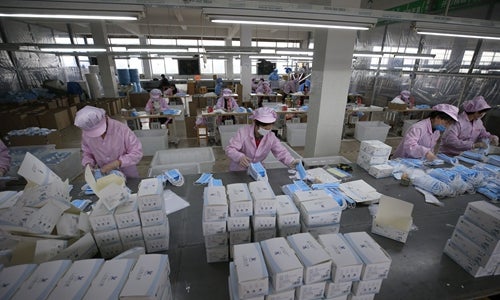The outbreak of Coronavirus Disease 2019 (COVID-19), first in China, and then globally, including in the United States, is drawing attention to the ways in which the U.S. economy depends on manufacturing and supply chains based in China. This report aims to assess current developments and identify immediate and longer range China trade issues for Congress.
An area of particular concern to Congress is U.S. shortages in medical supplies— including personal protective equipment (PPE) and pharmaceuticals—as the United States steps up efforts to contain COVID-19 with limited domestic stockpiles and insufficient U.S. industrial capacity. Because of China’s role as a global supplier of PPE, medical devices, antibiotics, and active pharmaceutical ingredients, reduced exports from China have led to shortages of critical medical supplies in the United States. Exacerbating the situation, in early February 2020, the Chinese government nationalized control of the production and distribution of medical supplies in China—directing all production for domestic use—and directed the bureaucracy and Chinese industry to secure supplies from the global market. Once past the initial peak of its COVID-19 outbreak, the Chinese government appears to have prioritized certain countries and selectively released some medical supplies for overseas delivery.
Congress has enacted legislation to better understand and address U.S. medical supply chain dependencies, including P.L. 116-136, The Coronavirus Aid, Relief, and Economic Security (CARES) Act, that includes several provisions to:
- expand drug shortage reporting requirements;
- require certain drug manufacturers to draw up risk management plans;
- require the U.S. Food and Drug Administration (FDA) to maintain a public list of medical devices that are determined to be in shortage; and
- direct the National Academies of Science, Engineering, and Medicine to conduct a study of pharmaceutical supply chain security.
Other potential considerations for Congress include whether and how to further incentivize additional production of health supplies, diversify production, address other supply chain dependencies (e.g., microelectronics), fill information and data gaps, and promote U.S. leadership on global health and trade issues.
The crisis that merged for the U.S. economy is defined, in large part, by a collapse of critical supply, as well as a sharp downturn in demand, first in China and now in the United States and globally. As China’s manufacturing sector recovers, while the United States and other major global markets are grappling with COVID-19, some fear China could overwhelm overseas markets, as it ramps up export-led growth to compensate for the sharp downturn of exports in the first quarter of 2020, secure hard currency, and boost economic growth. China may also seek to make gains in strategic sectors—such as telecommunications, microelectronics, and semiconductors—in which the government undertook extraordinary measures to sustain research and development and manufacturing during the COVID-19 outbreak in China.
R46304Karen M. Sutter is the Coordinator Specialist in Asian Trade and Finance at the Congressional Research Service.
Michael D. Sutherland is an analyst in International Trade and Finance at the Congressional Research Service.
Andres B. Schwarzenberg is an analyst in International Trade and Financeat the Congressional Research Service.
To read the full report, click here.

